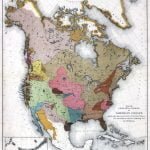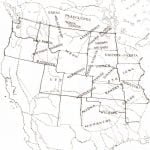
The divisions marked on this map are not absolute but relative. Rarely can a tribe be found anywhere that does not share some of the cultural traits of all its immediate neighbors. Yet, certain groups of tribes often have highly characteristic traits in common; hence, they are said to be of the same general culture type. Thus the tribes discussed in North American Indians Of The Plains have a number of peculiar traits whose distribution in more or less complete association is taken as indicating the geographical extent of a type of culture. The fact that these boundaries almost coincide with the limits of the treeless prairies and plains and that this culture is most intensified among the tribes living in the Great Plains, has given rise to the term Plains area. In the same way other parts of the continent appear as the homes of peculiar culture types. Anthropologists generally recognize at least eleven such areas whose approximate extents we have indicated in the accompanying map. The types for each of these are illustrated as space permits in the four halls on the first floor of the Museum. As will be exemplified in the text, the lines separating these areas are somewhat arbitrary. A more correct method would be to color the areas and divide them by broad bands in ever changing mixtures of the two colors, but only in a few instances have we sufficient data to do even this accurately. Hence, the approximate line seems the best designation of culture boundaries.

Reference to a linguistic map of North America will show that there is little correspondence between linguistic stocks and culture type, for while in some cases the two lines on the map coincide, in others, they show no approach whatsoever. Again, while the physical types of the Indians show some tendencies to agree in distribution with cultural traits, they also show marked disagreements. Hence, it is not far wrong to say that if, according to the data now available, we superimposed cultural, linguistics, and physical type maps, we should find them with few boundaries in common.

Returning to the consideration of culture areas and referring to the tribal map, we see that the tribes of Plains Indians in a central position are the most typical, while their immediate neighbors show tendencies to live like more distant tribes. What we find, then, is a kind of culture center, where the purest types are found, while surrounding this center are less pure cultures. Each of the designated culture areas in North America contains such a center where the true type of culture is to be found.
Discover more from Access Genealogy
Subscribe to get the latest posts sent to your email.
